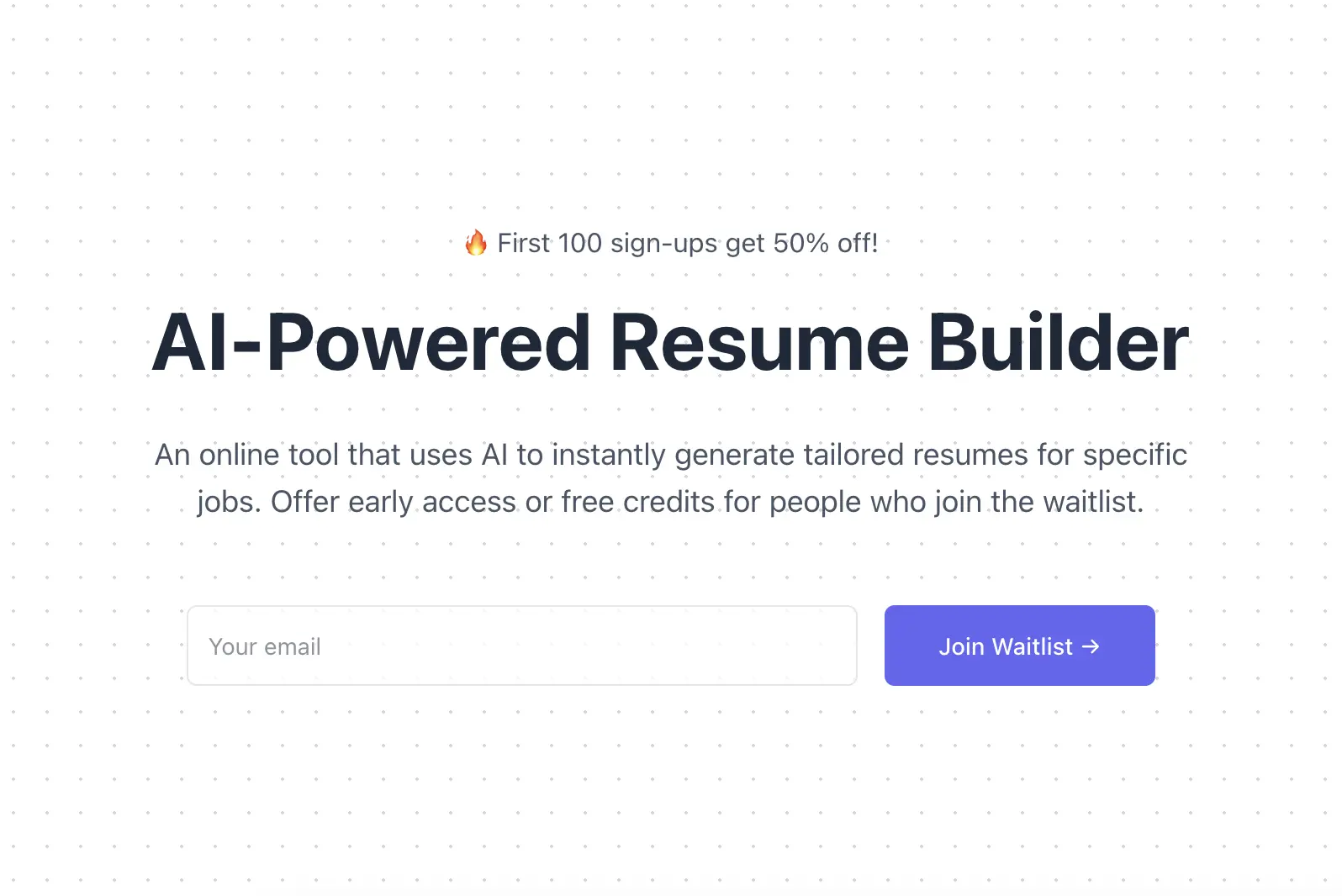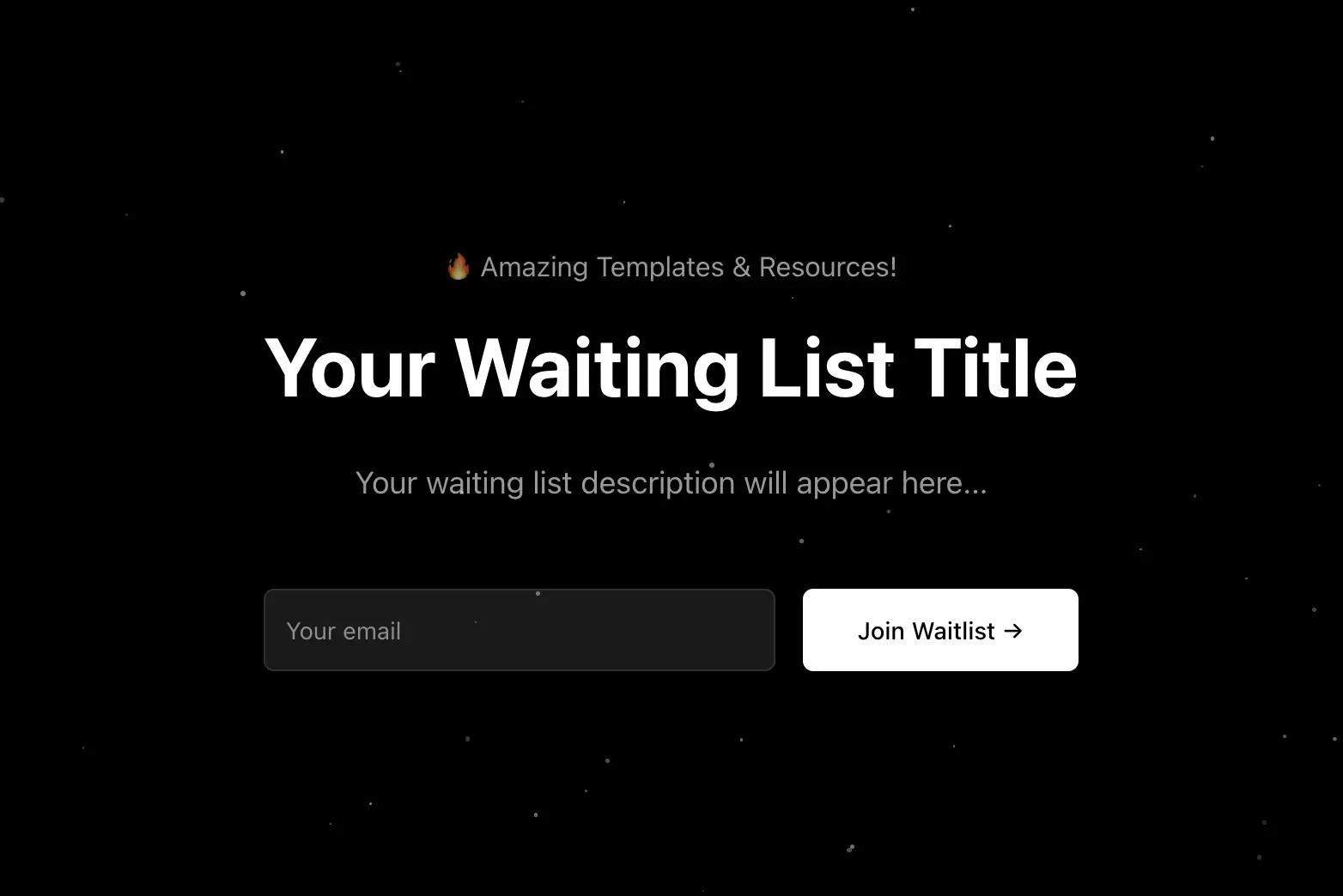
Picture this: you've spent months or maybe even years pouring your heart into building a product. You finally launch it… and nothing happens. No sign-ups. No sales. Just silence. Brutal, right? Unfortunately, this is exactly what happens to many entrepreneurs who skip Idea Validation.
That's why validating your idea early is so important. It gives you clarity on whether people truly want what you're offering before you invest more time, money, and energy.
One of my favorite ways to approach Idea Validation is by building a waiting list. It's a simple, low-cost method to get real interest without needing to create the product first. In this guide, I'll walk you through why a waiting list is such a powerful validation tool and how you can use it alongside other proven strategies.
What's Idea Validation, Anyway?
Let's break it down: idea validation is basically testing if people care about what you're offering. Whether it's a product, a service, or some new business idea, you want answers to questions like:
- Do people even want this?
- Will they pay for it?
- Is this a big enough problem to solve?
Bottom line? It's about getting real feedback before you pour your resources into building something no one needs.
Why Bother Validating Your Idea?
Because Building on Assumptions Is Risky Business
Here's the thing: a lot of startups fail because they built a solution looking for a problem. Instead of solving something real, they chased an idea they thought people wanted.
Idea validation flips that around. It makes sure you're solving a real problem for real people. And honestly? It can save you from wasting a ton of time and money on the wrong thing.
Why a Waiting List Is Your Secret Validation Weapon

A Waiting List = Proof People Actually Care
Here's why I love a waiting list: it's a super easy, low-friction way to see who's interested. If someone's willing to hand over their email just to get early access? That's a pretty strong signal they're excited about what you're working on.
Likes, follows, retweets? Sure, they're nice. But a sign-up? That's intent. That's someone saying:
"Hey! I'm in. Keep me posted."
Honestly, it's one of the strongest validation signals you can get before you've even launched.
You Can Test Product-Market Fit Without Building a Thing
Another perk? Your waiting list tells you who your early adopters are. You might discover things you didn't expect, like which age groups are most excited, or which features people care about most.
Plus, you can email your waitlist and ask questions, send surveys, or even offer early deals to test pricing and messaging. It's a goldmine for insights.
Look at These Companies That Nailed It with a Waitlist
Don't just take my word for it. Some huge companies used waiting lists to validate (and grow):
- Dropbox: Their viral referral waitlist exploded from 5,000 to 75,000 users basically overnight.
- Robinhood: They racked up over 1 million users on their waitlist before even launching.
- Superhuman: They made their email app invite-only with a waitlist, attracting top-tier early adopters.
See? A waiting list doesn't just validate. It can also build serious hype.
How to Build a Killer Waiting List That Converts
Start with a Simple Page
Don't overcomplicate it. You don't need a fancy website. Just a clean one-pager with a clear offer and an email sign-up form.

Write a Value Prop That Hits Home
Tell people exactly what problem you're solving, and why it matters. Don't ramble about features. Talk about benefits.
Example:
"Finally, a budgeting app that saves you money automatically, without the spreadsheets."
See how that's punchier than listing a bunch of functions?
Add a Call-to-Action That Pops
Your call-to-action (CTA) should be clear and actionable:
- Join the waitlist
- Reserve your spot
- Get early access
Also? Make that button stand out visually. Nobody clicks a boring gray button.
Use Scarcity to Make People Act Faster
Want to give folks a little push? Tap into FOMO (fear of missing out) by adding scarcity:
- Only 500 early access spots available.
- First 100 sign-ups get 50% off.
People act faster when they feel they might miss out!
How to Get People to Join Your Waiting List
Post It Everywhere on Social Media
Share your landing page where your audience hangs out. LinkedIn, Instagram, Twitter, TikTok, you name it. Use hashtags, post in groups, and engage with niche communities.
Use Paid Ads for Quick Wins
Got a little budget? Run Facebook or Google Ads to test different audiences. You don't need to spend big, sometimes $50-100 is enough to validate early demand.
Partner with Influencers or Related Brands
Team up with micro-influencers or complementary brands. Their shoutout can build trust and send traffic your way without costing a fortune.
How Do You Know If Your Validation Worked?
Track These Metrics
- Sign-up rate: Are 20-30% of your visitors signing up? That's a solid sign your value prop is landing.
- Referral shares: Did people invite friends? If yes, you're onto something viral.
- Email engagement: Are your waitlist folks opening, clicking, and replying to emails? If not, your messaging might need tweaking.
Other Smart Ways to Validate Your Idea
A waiting list rocks - but it's not the only tool. Try these too:
Talk to Potential Customers
Interviews are underrated. Ask people about their pain points, struggles, and reactions to your idea. You'll get insights you can't find in data alone.
Launch a Bare-Bones Prototype or MVP
Build the simplest possible version of your product to let users test it out. Their reactions will tell you what's working and what's not.
Run Quick Surveys or Polls
Ask your audience what they want most, what features they'd pay for, or how much they'd pay. Tools like Typeform or Google Forms make this easy.
Watch Out for These Validation Mistakes
- Collecting emails without testing if people will actually pay
- Listening to feedback from people who'd never buy
- Spending weeks perfecting the landing page instead of launching
- Promising big features you can't deliver on time
Trust me, you don't want to fall into these traps.
FAQs About Validating Your Idea
Q1: How many people do I need on my waitlist to validate my idea?
A: Aim for 50-100 sign-ups to show meaningful interest. More is great, but even 20 excited folks is a good start.
Q2: Do I need a product built to start a waitlist?
A: Nope! That's the beauty of it. A landing page is all you need to test early interest.
Q3: Should I charge people to get on the waitlist?
A: Usually not, but you can test with paid pre-orders if you want stronger validation.
Q4: How long should I keep the waitlist open?
A: 4-8 weeks is a solid window to build excitement and gather sign-ups before launch.
Q5: Can a waitlist work for B2B products?
A: Absolutely! Especially if you pair it with early demos or pilot programs.
Q6: What should I send to my waitlist subscribers?
A: Keep them in the loop! Send updates, sneak peeks, surveys, or behind-the-scenes content to keep excitement up.
Final Thoughts: Validate Smarter, Not Harder
If you want to turn your idea into a successful product, start with validation. And honestly? A well-built waiting list is one of the easiest, cheapest, and smartest ways to test demand.
Don't wait until launch day to find out if anyone wants what you've built. Validate early, validate smart, and give yourself the best shot at success!

Written by Terry Wilson
Expert in startup validation and product development with over 8 years of experience helping entrepreneurs bring their ideas to market.
Share this article
Have an Idea? Let’s Test It Together.
- Launch your waitlist in seconds!
- Get expert feedback, not guesswork
- Know if your idea is worth building
- Learn fast, fail less, and build smarter
Related Articles

How to Test a Business Idea: 10 Steps to Know It's a Winner
Discover how to test a business idea before investing time and money. These 10 practical steps will help you validate your concept and ensure it has real potential to succeed.

How to Validate a Startup Idea: 10 Steps to Test Your Dream
Learn how to validate a startup idea with our practical, no-nonsense guide. These 10 proven steps will help you determine if your concept has real potential before investing time and money.